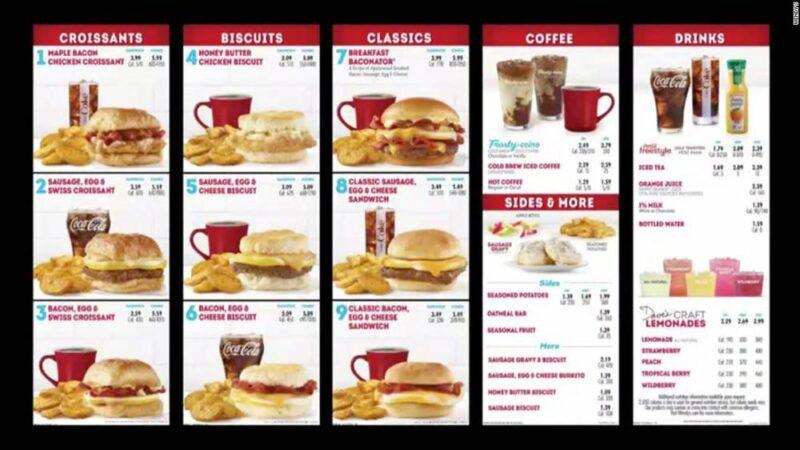New York (CNN Business)On March 2, Wendy’s finally launched its highly anticipated breakfast menu nationwide. Then, two weeks later, the morning commute basically collapsed because of lockdown measures encouraging people to work from home.
Wendy’s breakfast should’ve flopped because of this. It didn’t. The appetizing array of new menu items, like the Breakfast Baconator and Frosty-ccino, have been a hit and have bolstered Wendy’s bottom line during a second quarter that was gloomy for its competitors. Breakfast now accounts for 8% of Wendy’s total sales, a figure the fast food chain is celebrating because it hoped it would amount to 10% of total sales by the end of the year.
“We could not be more pleased with our breakfast daypart since its launch in early March,” CEO Todd Penegor said in this week’s earnings call. Interest in breakfast hasn’t faded, he said, noting sales at stores open at least a year finally turned positive in July because of the “continued strength” of the new breakfast offerings. Wendy’s immediate success can be partially attributed to the lockdowns, rivals’ struggles (notably McDonald’s) and even boredom. Read More”With not much else to do, some consumers welcome the opportunity to try a fun new menu item during this crisis,” Jill Failla, senior food service analyst at Mintel. told CNN Business. “This trial gives them something to talk about with family, friends and on social media.”Unlike McDonald’s and Starbucks, which have mostly conservative breakfast menu items, such as Egg McMuffins and croissants, the Wendy’s menu has less traditional items, including a breakfast-themed fried chicken sandwich and cold brew coffee mixed with ice cream. Those represent “relevant menu trends” that appeal to younger a demographic, Falla noted.It also didn’t hurt that Wendy’s struck when McDonald’s was ailing. The chain has boasted of its success during the mornings, but has struggled in recent years with new competition from a variety of places.
Breakfast was born

Wendy’s breakfast menu.Wendy’s announced it was entering the competitive breakfast wars in September 2019. It saw an opportunity to grow in a dormant time of the day: More people make breakfast at home than any other meal, and the morning remains the only growth market for the fast food industry, according to research group NPD.Roughly 300 of Wendy’s 6,000 US restaurants served breakfast, including a bacon sandwich and a honey butter chicken biscuit. A cohesive menu supported by a national marketing campaign “provides incredible growth opportunities,” Penegor said at the time. Wendy’s (WEN) had to convince its franchisees that an entirely new menu would be a relatively easy lift. For starters, the company worked closely with restaurants and created a menu that doesn’t require new equipment. Franchises had to spend upwards of $10,000 on equipment the last time it offered breakfast several years ago. Only three employees are needed to work the shift, which is one fewer employee than last time.Wendy’s hired about 20,000 employees and said it wanted to initially spend $20 million on marketing. However, some of the marketing spend was put on pause because of the pandemic. This week, Penegor said Wendy’s is going to spend $15 million to promote breakfast later this year “as more and more people fall back into their daily routines.”Five months into the endeavor, a Wendy’s spokesperson told CNN Business that its top-selling breakfast items are the Breakfast Baconator, honey butter chicken biscuit, maple bacon chicken croissant and the Frosty-ccino.
Tough competition
Breakfast is filled with a number of restaurants battling for taste bud supremacy, including Panera, Starbucks, Dunkin’, Taco Bell and, the behemoth itself, McDonald’s. For the companies that report earnings, the second quarter wasn’t as rosy compared to Wendy’s — notably McDonald’s (MCD). The world’s largest fast food was struggling during breakfast prior to the pandemic and continues to face difficulties. McDonald’s CEO Chris Kempczinski said in its most recent earnings call that breakfast “was one area of pressure” because of new competitors. The chain also temporarily eliminated its all-day breakfast, among other items, to help restaurants’ maintain costs. The company didn’t say when it would return.Coffee chains Dunkin’ (DNKN) and Starbucks (SBUX) also said they’re struggling in the mornings. Both recently reported deep declines in revenue and visits because people aren’t stopping by as much. Starbucks CEO Kevin Johnson said the “disruption to the weekday morning routines, notably commuting to work and school, is a headwind.” Dunkin’ noticed a drop off in visitors from 6 am to 9 am, but some are visiting from 11 am to 2 pm for snacks or non-coffee drinks. Still, don’t count them out yet. McDonald’s Kempczinski said there’s “going to be a rededication from a marketing and investment standpoint to go after breakfast.” He also hinted at “innovation,” a.k.a. new menu items to be unveiled later this year. (In January, McDonald’s trialed Chicken McGriddles and McChicken Biscuit nationwide, perhaps providing a hint about what’s next considering Wendy’s success with their chicken sandwiches.)Starbucks and Dunkin’ also continually add new items to their menu, too. The former rolled out a new breakfast sandwich using Impossible, a meat-alternative. In August, Dunkin’ will launch its always-popular pumpkin-themed menu with flavored coffees and donuts.
Wendy’s sustaining its success in the morning depends on if “consumers enjoy the breakfast trial enough to repeat their purchases,” Failla said. “The feedback so far has been mostly positive, but it will be an uphill battle for Wendy’s during this public health and economic crisis,” she concluded.
Source: edition.cnn.com

